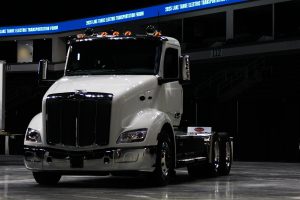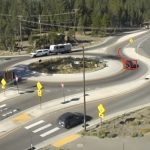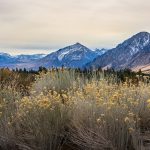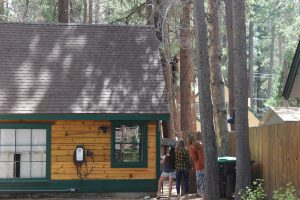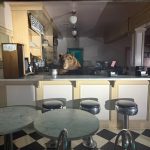Electric transportation on and around Tahoe discussed at collaborative forum
STATELINE, Nev. – Regional leaders, company executives, local business owners and the public came together to discuss electric transportation on and around Lake Tahoe during the 3rd Lake Tahoe Electric Transportation Forum at the Tahoe Blue Events Center on Wednesday, Aug. 20.
With three panels focused on Lake Tahoe, panelists and moderators participated with the audience to explore Tahoe’s progress, challenges and form a collective vision for electrifying transportation.
A vision for the future
The first panel started with a look ahead, exploring what that collective vision could look like with a majority of panelists already leading the EV way in the region.
Those include:
- Gavin Feiger (panel moderator), policy director, League to Save Lake Tahoe
- Devin Middlebrook, government affairs manager, Tahoe Regional Planning Agency
- Sara Letton, sustainability coordinator, City of South Lake Tahoe
- John Friedrich, chief development officer, Skycharger and former City of South Lake Tahoe councilmember
Tammie Bostick also joined the panel, executive director of Utah Clean Cities and Communities and offered a framework—assess, plan, build, operate—for switching to electric.
The panelists engaged with the audience to envision a future that reduces all around vehicle reliance with easy and accessible alternative modes of transportation, all while electrifying those vehicles that do operate, including transit and micro-transit with the help of a solar powered infrastructure.
Panelists and the audience also identified ideal types of locations for both slow (Level 1) and fast (Level 2) EV chargers. The collective identified that when it comes to getting day visitors to bring their EVs to Tahoe, fast chargers are more important on the way to Tahoe. However, charging at resorts, free parking and free charging could further incentivize bringing zero emissions vehicles to the region.
Friedrich noted that he expects the market to dictate where fast chargers go, but that Level 2 chargers would likely need public agencies and funding to implement.
The collective also evaluated where to centralize these slow chargers in order to incentivize people to leave their cars for extended periods to charge and use alternative modes during their time here. Feedback offered transit hubs as an option with the caveat that the transit would need to be reliable, frequent and have many stops. Parking garages, schools, and marinas were also identified locations. Other insights provided that there would need to be many slow chargers to meet the demand and keep people from having to move their cars.
Although some offered trailheads as an option, Middlebrook explained the challenge at those locations is the lack of power infrastructure to accommodate chargers, but highlighted that campgrounds have potential as they are typically set up with adequate power.
Although many strides are yet to be made, the panelists emphasized the opportunity.
“Tahoe is the perfect testing ground for this type of technology,” Middlebrook said, “and it really fits in line with the spirit and ethos of the region.”
Electrifying experiences on the water
The forum delved into the evolution and potential for electrifying recreation and commercial experiences on Lake Tahoe with a panelist of regional pioneers on the topic.
David Topol, director of Homewood High & Dry Marina, installed the lake’s first on-the-water electric boat charging station.
CEO of FlyTahoe, Ryan Meinzer, is currently working on implementing America’s first hydrofoil electric ferry on Tahoe for zero-emission and faster lake crossings.
Bob Hassett, founder of Action Water Sports, Camp Richardson Marina president, and owner of Round Hill Pines Beach Resort, also joined the panel. In his over three decades of marina experience, Hassett was instrumental in starting the South Shore Water Taxi on Lake Tahoe in 2003.
Together, the panel discussed the challenges of navigating these first-of-its-kind endeavors on Lake Tahoe, and the lessons they’ve learned, including permitting, power infrastructure upgrades, fluctuating demands and water levels.
They also identified what needs to happen to expand boat electrification on the lake, from increased boat charging stations, and more advanced electric boat technology, to assessing how that might change marina and dock operations.
Topol expressed excitement behind being the first marina to implement the on-the-water electric boat charging station, but noted it only makes sense if there’s a network of them to reduce range anxiety and offer flexibility. Hassett is currently exploring options for electric charging at Round Hill Pines Beach Resort. Since Homewood’s installation, Tahoe City Marina has installed an electric boat charging station as well.
Meinzer expressed the potential for the hydrofoil ferry based on its use in Sweden, which has seen a large demand and has cut commute times in half. Due to carrying the weight above the water, it has the environment benefit of not eroding the shoreline, while also carrying speed. Another local benefit to the ferry could be winter operations, which would bring business year around to marinas.
The panel identified that for water commuting to be successful, there has to be a focus on the land-side infrastructure that would not only get passengers to the marinas, but also get them where they need to go once they dock.
Transitioning to electric buses
On another Tahoe-centric panel, Jason Burke, senior transport planner with the Tahoe Transportation District, discussed the district’s plans to transition to a zero-emission fleet. One factor the district has been navigating is how to meet the two different services the district provides with transit not only around the south shore of Lake Tahoe, but also to and from the Carson Valley.
Jonathan Garrett, a transit and zero-emissions consultant with Stantec, joined the panel and discussed how critical it is to assess and plan these types of transitions, whether it’s the pros and cons of electric versus hydrogen fuel cell technology, evaluating power requirements, understanding the challenges to converting and creating the infrastructure.
Burke explained TTD is working with experts, including Stantec, to make changes in a phased approach, which involves training staff, factoring charging times into service, as well as snow and other niche needs to the Tahoe area.
Understanding both the capabilities and limitations of alternatives such as electric and hydrogen fuel cells are paramount to any consideration.
Those capabilities and limitations are something panelist Jim Gee, director of public transit at Regional Transportation Corporation (RTC) in Washoe County, experienced when RTC started incorporating electric busses around 11 years ago. While the electric buses were emission-free, they had shorter daily ranges.
RTC is now incorporating hydrogen fuel cell vehicles, which go longer and have a much shorter refueling period compared to electric buses.
Costs are also something to consider, which Gee said, “If you’re going all in on hydrogen or battery electric or whatever, you’re not typically doing it to save money. You’re doing it for something greater, which is helping the environment.”
The Lake Tahoe Electric Transportation Forum is an annual event gathering local and and national experts, as well as the public to converge in finding innovative solutions for clean transportation in Lake Tahoe.
For more information, visit, laketahoeelectrictransportationforum.com/

Support Local Journalism

Support Local Journalism
Readers around the Lake Tahoe Basin and beyond make the Tahoe Tribune's work possible. Your financial contribution supports our efforts to deliver quality, locally relevant journalism.
Now more than ever, your support is critical to help us keep our community informed about the evolving coronavirus pandemic and the impact it is having locally. Every contribution, however large or small, will make a difference.
Your donation will help us continue to cover COVID-19 and our other vital local news.

